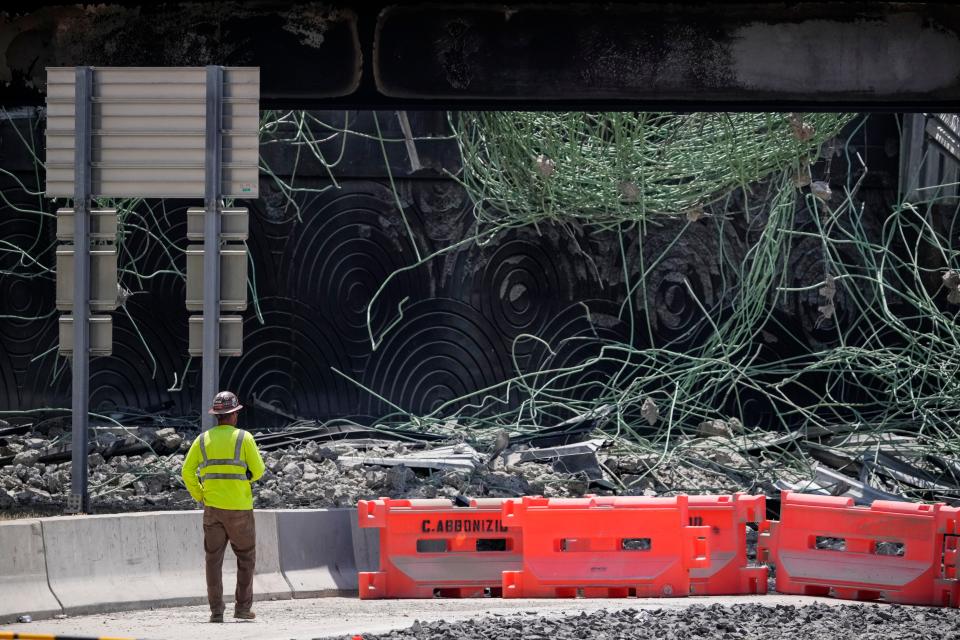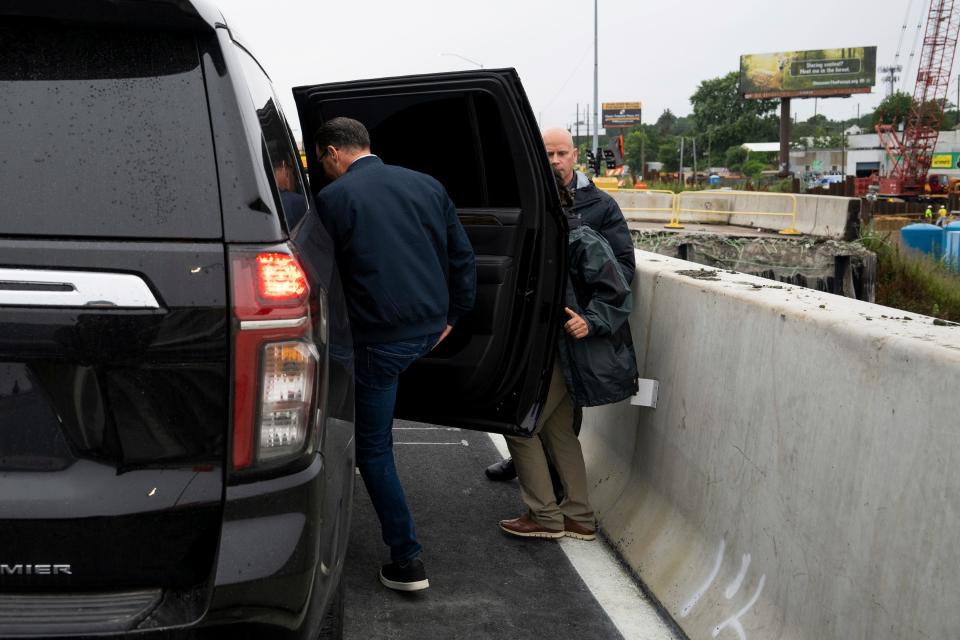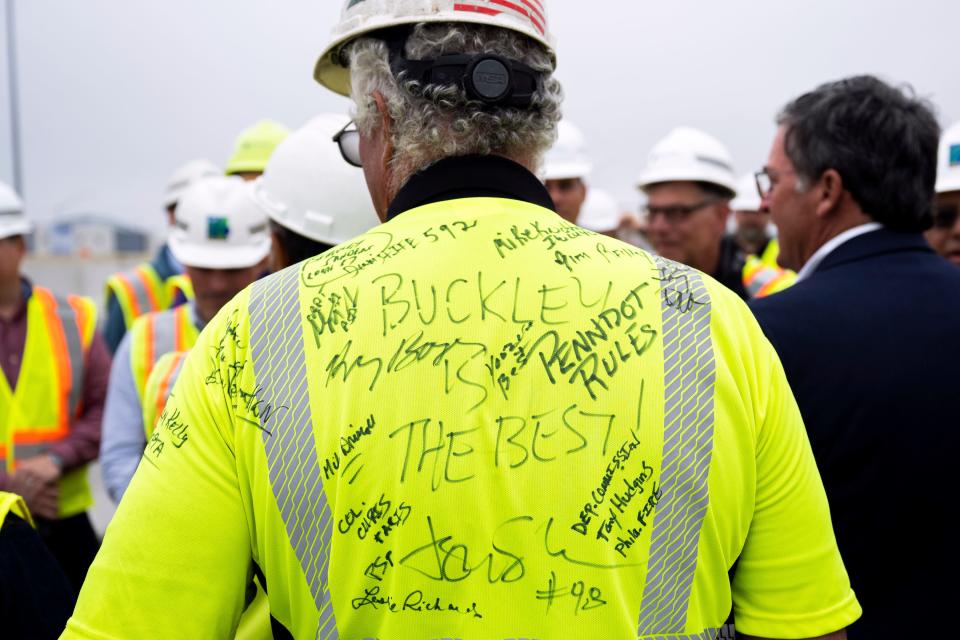Collapsed section of I-95 in Philadelphia reopened Friday with temporary lanes, fresh paint
The damaged portion of Interstate 95 in Philadelphia was reopened ahead of schedule Friday, less than two weeks after a deadly collapse shut down the major East Coast thoroughfare and caused chaos for commuters.
Workers put the finishing touches on six temporary lanes that will serve motorists during construction of a permanent bridge.
“This was a moment of civic pride for Philly and Pennsylvania. We all came together and we proved that we could do big things again in Pennsylvania,” Gov. Josh Shapiro said Friday at a news conference at the site.
After he spoke, a procession of fire engines — one carrying Philadelphia's pro sports mascots — and police vehicles crossed the northbound lanes of I-95, opening the new roadway as construction workers in hard hats looked on.

The critical I-95 section had collapsed after a tanker truck caught fire, killing the driver. Earlier this week, Shapiro said the lanes would reopen over the weekend, ahead of schedule. In the aftermath of the collapse, exerts predicted full repairs would take months.
The section of I-95 that collapsed is in northeast Philadelphia's Tacony neighborhood. The interstate, which runs along the East Coast, is a major local artery for commuters in Pennsylvania, Delaware and New Jersey, as well as summer beach-goers headed to the Jersey Shore and Delaware's many beach towns.
How did Philadelphia reopen I-95 this quickly?
On Thursday, Shapiro said crews needed 12 hours of "dry weather" to "complete the paving and striping process," in order to reopen I-95.
The governor said workers were racing against time to beat rain that was in the forecast. To speed up the repairs, construction teams borrowed a jet dryer from a private raceway to "help dry this section of I-95 and keep us on schedule," Shapiro said on Twitter.

The state's transportation department also trucked in 2,000 tons of lightweight recycled glass nuggets to fill in the collapsed area, NBC 10 News reported.
The department told the news outlet they worked to avoid supply-chain delays for other materials. Crews are still working on a replacement bridge that will be built next to I-95 to reroute traffic while workers excavate the area around the exit ramp, officials told NBC 10.
President Joe Biden joined Shapiro on a helicopter tour of the site a little more than a week after the collapse and praised the design as “incredibly innovative in order to get this work done in record time.’’
The 24-hour construction work was live-streamed, drawing thousands of viewers online, in what the Philadelphia Inquirer called a "the sleeper hit of the season."
"There’s no high drama, no close-ups, no narration. Just action – constant, steady, sure. Almost hypnotic. And we can’t seem to look away," the outlet wrote as part of its liveblog coverage Friday morning.
Why full I-95 repair could take 'months,' experts say
Earlier this month, Shapiro said the complete rebuild of I-95 would take "some number of months."
The I-95 collapse in Philadelphia is a real-life physics lesson – the result of what happens when building materials come in contact with intense and prolonged heat, reported the Delaware News Journal, part of the USA TODAY Network.
Steel girders and concrete used in bridges can lose 50% of their strength at about 1,100 °F and 950 °F, respectively, according to Andrew W. Herrmann, past president of the American Society of Civil Engineers.
The fire, which ignited when a tractor-trailer hauling gasoline flipped on an I-95 off-ramp under the overpass, is estimated to have burned as hot as 2,000 °F, Hermann told the News Journal.
"So with that type of a fire, we are way over what would cause damage to the bridge and actually lead to its collapse," he said.

Parts of the interstate that did not collapse could have suffered damage from the heat too, said Thomas Gernay, an assistant professor of civil engineering at Johns Hopkins University, who studies ways to protect structures from fires.
"The parts of the structure that did not collapse can be permanently damaged by the material degradation and the movements induced by the heat exposure," Gernay said in an email to USA TODAY.
Philly residents joke about fiery I-95 failure
This month, residents in the greater Philadelphia area have had their normal commutes circumvented by miles of detours that caused delays and frustration for drivers, USA TODAY reported.
@99centburrito this guy pretty much summed up living in philadelphia #i95collapse #phillytok #phillysports ? original sound - casey
In the weeks since the devastating collapse, a popular video featuring a local man talking on-camera to CBS has gone viral on TikTok, garnering nearly 348,000 likes on the platform.
In the video, Peter McLaughlin of Philadelphia's Tacony neighborhood, where the collapse happened, compares the loss of I-95 to when the city lost the 2023 Superbowl against the Kansas City Chiefs and when the Phillies lost the 2022 Major League Baseball World Series to the Houston Astros.
"Philly doesn't have the best luck right now," says McLaughlin, smiling from beneath a backwards baseball cap. "Looks like we're just taking L's," he says.

Other Pennsylvania residents have expressed frustration and disappointment, specifically about how the bridge collapse negatively affected their daily car commutes.
Maureen Gross, of Newtown Township, Pennsylvania, told USA TODAY she was hoping her Camden, New Jersey, employer would allow her to work from home. Otherwise, she was anticipating a long, grueling summer.
"It's going to drastically change my commute, on top of a not-so-great commute to begin with," she said.
Contributing: Esteban Parra, Delaware News Journal; Francisco Guzman, Grace Hauck, Thao Nguyen, USA TODAY; Associated Press
This article originally appeared on USA TODAY: I-95 Pennsylvania lanes open, cars drive down lanes on livestream
